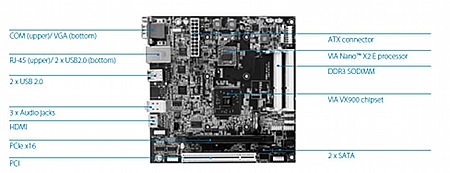Mini-ITX board uses Via’s Nano X2 E-Series CPU
Jul 7, 2011 — by LinuxDevices Staff — from the LinuxDevices Archive — 4 viewsVia Technologies announced a Mini-ITX board using its dual-core Nano X2 E-Series processor. The Epia-M900 accepts up to 8GB of RAM, has VGA and HDMI video outputs, includes both PCI and PCI Express x16 expansion slots, and offers both S/PDIF and analog audio outputs, according to the company.
Via has already released a variety of Mini-ITX boards using its embedded-optimized, 64-bit Nano E-Series processor, including the VB8004, Epia-M860, Epia-M850, and Epia-M840. The new Epia-M900, however, is the first to employ the dual-core Nano X2 E-Series processor.
Announced in May, the Nano X2 E-Series is an embedded-oriented version (with seven-year availability) of the dual-core Nano X2 Via released in January. Pin-to-pin compatible with earlier Nanos, this CPU comes in 1.2GHz or 1.6GHz versions, according to the company.
Like the revised single-core Nanos that debuted in November 2009, the Nano X2 E-Series supports 64-bit instructions, Via's VT virtualization technology, and Intel's SSE4 instruction set extensions. (Prior Nanos supported only SSE3, just like Intel's own Atom.)

Via's Epia-M900
(Click to enlarge)
Apart from its 1.6GHz Nano E-Series processor, the Epia-M900 (above) also employs Via's VX900 northbridge/southbridge. Able to provide 1080p video playback "without incurring a heavy CPU load," the VX900 offers hardware acceleration for H.264, MPEG-4/AVC, MPEG-2, VC-1, WMV-HD, AVS, and Blu-ray, according to the company.

More detail on the Epia-M900
(Click to enlarge)
Via says the Epia-M900 accepts up to 8GB of DDR3 memory in two SODIMM sockets, and has two SATA connectors for fixed storage devices. The board also has one PCI Express x16 expansion slot and one 32-bit PCI slot, the company adds.

The coastline on Via's Epia-M900
(Click to enlarge)
The Epia-M900's coastline (above) features HDMI and VGA video outputs, plus four USB 2.0 ports, a gigabit Ethernet port, a serial port, and audio jacks (mic in, line in, and line out). Onboard headers, meantime, provide access to: LVDS video; four more USB 2.0 host ports, a USB client, eight digital I/Os, three additional serial ports, a PS/2 port, and S/PDIF digital audio output, according to Via.
Specifications listed by Via for the Epia-M900 include:
- Processor — Via Nano X2 E-Series clocked at 1.6GHz
- Chipset — Via VX900
- Memory — up to 8GB of DDR3 RAM
- Storage — 2 x SATA connectors
- Expansion:
- 1 x PCI Express x16 slot
- 1 x 32-bit PCI slot
- Networking — 1 x gigabit Ethernet; optional 802.11b/g/n module connects to internal USB port
- Other I/O:
- VGA
- HDMI
- LVDS (internal)
- 8 x USB 2.0 host ports (4 external, 4 internal)
- 1 x USB client (internal)
- 4 x serial ports (1 external, 3 internal)
- audio — jacks for mic in, line in, line out, plus header for front-panel mic in and line out
- 1 x S/PDIF (header)
- 2 x digital I/O (8 in, 8 out)
- 1 x PS/2 (header)
- Power — ATX connector; consumption n/s
- Operating range — 32 to 140 deg. F
- Dimensions — Mini-ITX (6.7 x 6.7 inches)
Epan Wu, head of Via's embedded platform division, stated, "The Via Epia-M900 brings high performance VIA dual core computing power to embedded devices for the first time. It will enable the creation of a wealth of innovative next generation digital signage, POS, Kiosk, ATM, home automation, healthcare and media client system design applications."
Further information
According to Via, the Epia-M900 is available now, though pricing was not cited. The board is said to be compatible with Linux as well as a passel of different Windows versions.
More information may be found on Via's Epia-M900 product page.
Jonathan Angel can be reached at [email protected] and followed at www.twitter.com/gadgetsense.
This article was originally published on LinuxDevices.com and has been donated to the open source community by QuinStreet Inc. Please visit LinuxToday.com for up-to-date news and articles about Linux and open source.